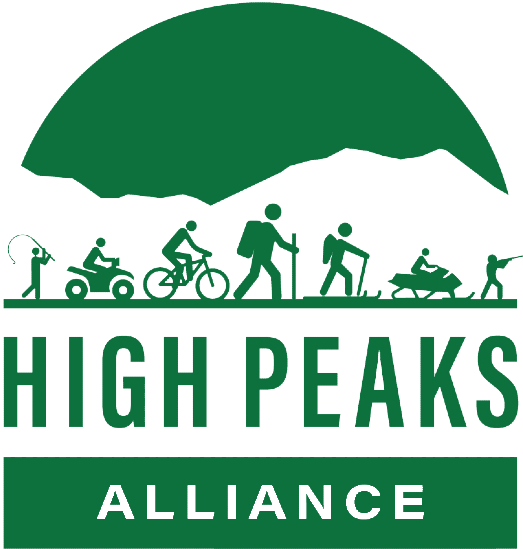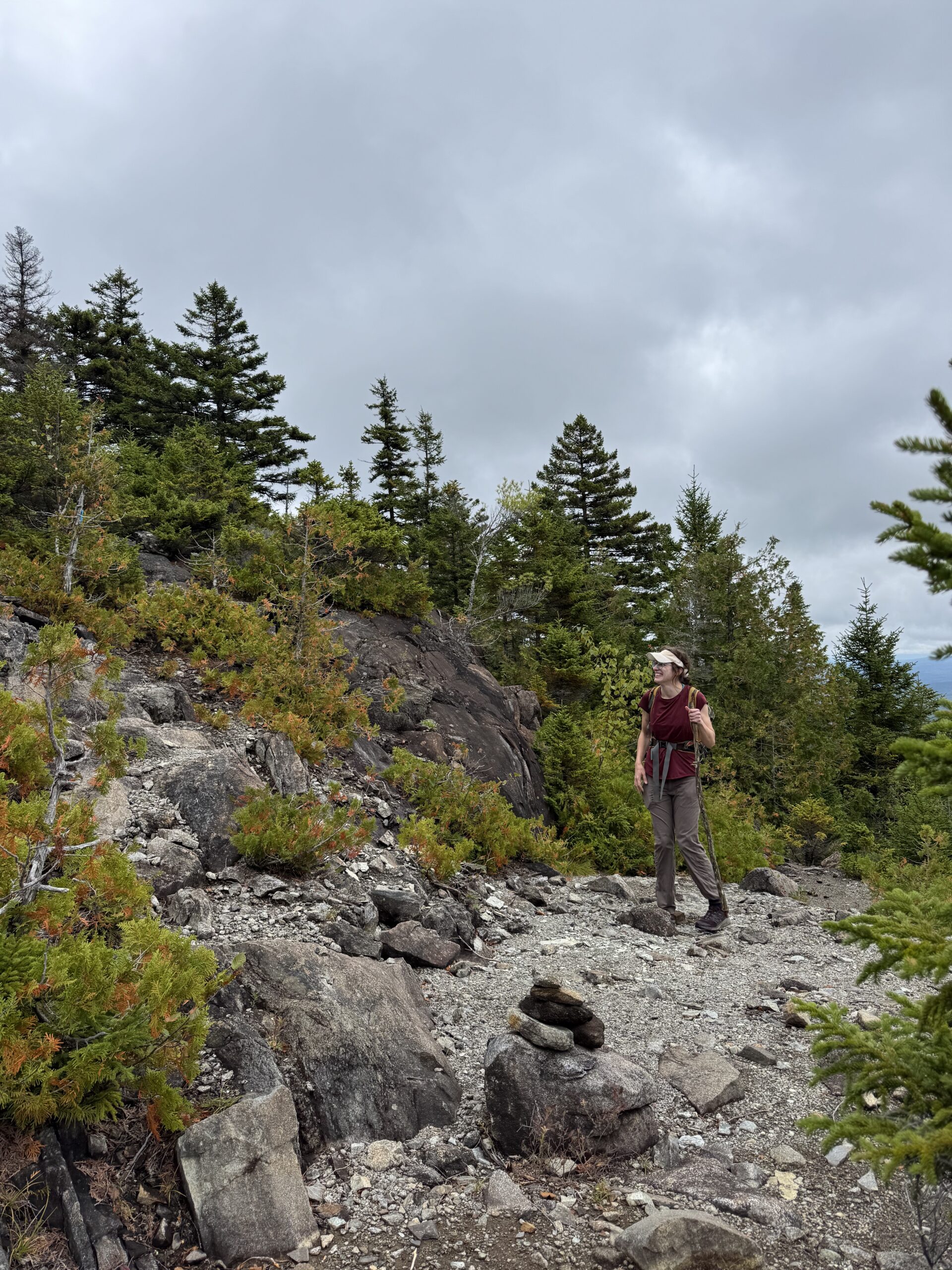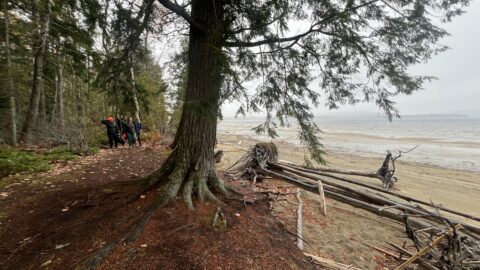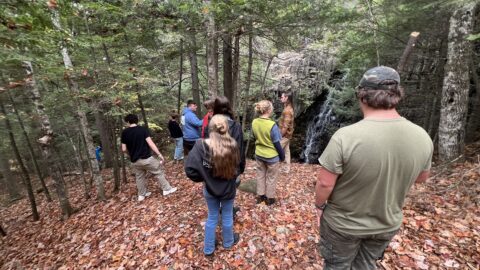Meet Rebecca Goldfine, Creator of Maine By Foot
Rebecca Goldfine, a Maine native raised in a family passionate about the outdoors, has channeled her love for nature into impactful conservation efforts. Through her blog, Maine By Foot, she maps and shares trails across the state, making the outdoors accessible to all. As a key contributor to the Scenic 7 guide and a member of the High Peaks Alliance’s Land Access Committee, Rebecca works to balance recreation, conservation, and landowner needs. In this interview, she shares her journey, insights, and vision for the future of this wild and beautiful landscape.

How Maine By Foot Got Its Start
What makes the High Peaks Region stand out to you personally?
It still feels wild to me. You get that sense of being able to get away. The other thing about the area that I think is really special is the community, it’s kind of extraordinary! The people, especially those who are working in the area of conservation, are special. You guys are all so disparate, yet committed, with a real sense of camaraderie and connection. This shows in the work you do and the trails that you can find up there, and the information about them. I think it’s that combination of good people and extraordinary beauty that makes it special.
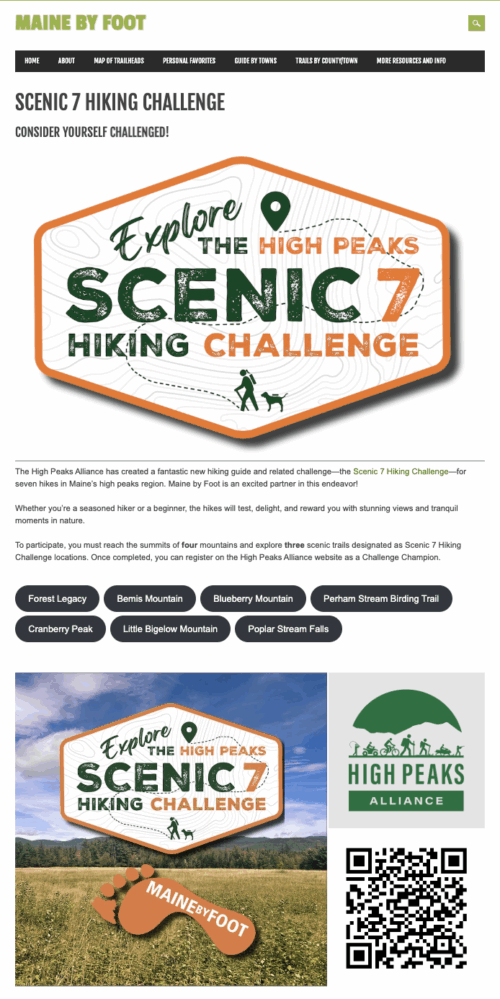
Access + Challenges = Balance
What inspired you to create Maine By Foot, and how has it grown since you began?
I started walking and mapping trails in 2011, and launched the site in 2012. Then it really got going in 2013. This was before AllTrails had taken over, and was right at the beginning of Maine Trail Finder. Land trusts back then also didn’t have as good online info as they do now. It wasn’t that long ago, but things are so different today in terms of finding online information about trails.
The impetus really was that I had just moved to a new town in Brunswick, to start a new job. I couldn’t find the local trails. I was like, are people hiding this information on purpose?
Also, my new job was an internship, an IT internship, which was pretty open-ended. I thought one thing I could do is teach myself how to make a website or figure out that whole world. I decided to make an online trail guide, find the local trails, post them, and teach myself how to use WordPress.
And…then something took over. I got obsessed! I started going out every weekend — hiking, hiking, hiking, mapping, mapping, mapping — putting it all online. People started to find the site and said that they liked it. And I’m a sucker for praise! I just loved the whole project. It’s connected me to so many people, like you guys. That’s been a wonderful part of it.

How Writing Meets Real-World Conservation
Could you share your experience co-writing the Scenic 7 and why you felt it was important?
I loved working on the Scenic 7 because I have no formal background or expertise in trail guides. It was really neat to watch how Doug and Sam approach trail writing, describing these trails and making them accessible to people. I learned a lot.
As a member of the Land Access Committee, what opportunities have been most meaningful for you?
I love conserving land. I am all for conserving land, for wildlife, for people, and for the climate. It’s really important to me. Even though I made Maine by Foot to encourage people to get outside, to love the outdoors, and to protect the outdoors, I think it’s an indirect route to that end result! When I can partner with organizations like the Alliance, I feel like I’m doing something tangible. And that makes me feel good.
The Future of Outdoor Access
When you think about access to trails and natural places, what has changed the most since you first started exploring them?
One thing I’ve noticed is that there are more accessible trails, which open up nature walks to people in wheelchairs or with bad knees or who are a little less steady on their feet. There are so many more universally accessible trails today than when I was growing up, and even since I started Maine by Foot. I think that development is fantastic.
I have also seen trails being closed off to the public after being open for years. I would say every year, I get requests from property owners to take down trails from my site. I sometimes worry I’m contributing to that by making these places better known in a way that might annoy a property owner. Over 13 years, I haven’t necessarily noticed the pace of that increase, but it’s definitely something that happens.
What challenges remain for public access in this region?
I think a couple of things. When people who didn’t grow up here move here, they might have a fear of the unknown and assumptions about hunting and land use. They don’t understand the State of Maine’s landowner law that protects them if they allow access. They don’t have the resources or know to reach out to IF&W, who will work with landowners.
I also think that sometimes landowners can have some legitimate reasons for concern about the way people behave on the land they make available. It is important that people use proper outdoor etiquette.
The third thing is that there’s no incentive for landowners; there’s no incentive for them to try to keep their land open. Maybe they should get a tax break for allowing public access, and get an even a more generous tax break if they have an established trail.
Why is it important to you that groups like HPA exist?
Maine doesn’t have a lot of federally protected land. So local people and organizations like HPA have had to step up, and they really have, with the support of landowners who donate or sell their land — often at a discount, the staff and volunteers who build and maintain trails, and donors, too, of course.
I read the other day that Maine’s land trusts have protected nearly 15 percent of the land here, providing public access to almost 3 million acres and more than 1,000 miles of trails. Altogether, I believe 22 percent of Maine’s land is conserved.
How do you see the Alliance balancing recreation, conservation, and landowner needs?
The coalition that you’ve put together, the fact that it has people coming to land use from so many different directions, is so cool. The hunters and the hikers and the mushroomers, I love it. I think it’s unusual. As frustrating as it can be sometimes to sit in the room with somebody who has a completely different perspective, the diversity makes us so strong.

The Future of High Peaks Hiking
How do you envision the future of hiking and outdoor experiences in the High Peaks?
I am confident it is just going to get better and better! As HPA and other conservation organizations protect the remaining wild lands out there, the region’s beauty will remain intact, drawing nature lovers for many, many years. Plus, HPA and its allies are so committed to public access that the trails, which are already numerous and well-maintained, will get better, and the amenities for outdoor people will get even better. I mean, I suppose in this scenario we will have to protect ourselves from being too popular!
Do you have a lesser-known spot you would like to recommend to our audience for their next hike?
I often find myself saying to people who visit the area, don’t miss the Jericho Steps (which used to be Reed Brook). I love that trail. Before it was rerouted to the other side of the stream, it felt like something out of Peter Pan, with funky bridges, fun signs, rock art — lots of these wonderful, interesting little touches. Now it’s a little bit more mainstream, literally! But still enchanting and fun — the trail builder was really dedicated to it, with a creative vision.
Closing Thoughts
Thank you, Rebecca, for sharing your passion for the High Peaks and your inspiring work with Maine By Foot and the Alliance. Your dedication to making trails accessible while advocating for conservation is motivating!
For those eager to explore the region, download the Scenic 7 Hiking Challenge booklet to discover its breathtaking trails, and visit Maine By Foot for more hiking inspiration across the state.
